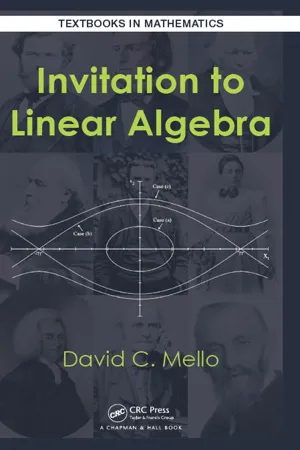
- 394 pages
- English
- ePUB (mobile friendly)
- Available on iOS & Android
Invitation to Linear Algebra
About This Book
Invitation to Linear Algebra is an informative, clearly written, flexible textbook for instructors and students.
Based on over 30 years of experience as a mathematics professor, the author invites students to develop a more informed understanding of complex algebraic concepts using innovative, easy-to-follow methods.
The book is organized into lessons rather than chapters. This limits the size of the mathematical morsels that students must digest, making it easier for instructors to budget class time.
Each definition is carefully explained with detailed proofs of key theorems, including motivation for each step. This makes the book more flexible, allowing instructors to choose material that reflects their and their students' interests.
A larger than normal amount of exercises illustrate how linear and nonlinear algebra apply in the students' areas of study.
Features
-
- The book's unique lesson format enables students to better understand algebraic concepts
-
- Students will learn key elements of linear algebra in an enjoyable fashion
-
- Large number of exercises illustrate the applications of the course material
-
- Allows instructors to create a course around individual lessons
-
- Detailed solutions and hints are provided to selected exercises
Frequently asked questions
Information
Lesson 30 | Powers of Matrices |
Lesson 31 | Functions of a Square Matrix |
Lesson 32 | Matrix Power Series |
Lesson 33 | Minimal Polynomials |
Lesson 34 | Direct Sum Decompositions |
Lesson 35 | Jordan Canonical Form |

Table of contents
- Cover
- Half Title
- Title Page
- Copyright Page
- Table of Contents
- To the Instructor
- To the Student
- Unit I: Matrices and Linear Systems
- Unit II: Determinants
- Unit III: A First Look at Vector Spaces
- Unit IV: More About Vector Spaces
- Unit V: Linear Transformations
- Unit VI: Matrix Diagonalization
- Unit VII: Complex Vector Spaces
- Unit VIII: Advanced Topics
- Unit IX: Applications
- Appendix
- Solutions and Hints to Selected Exercises
- References
- Index